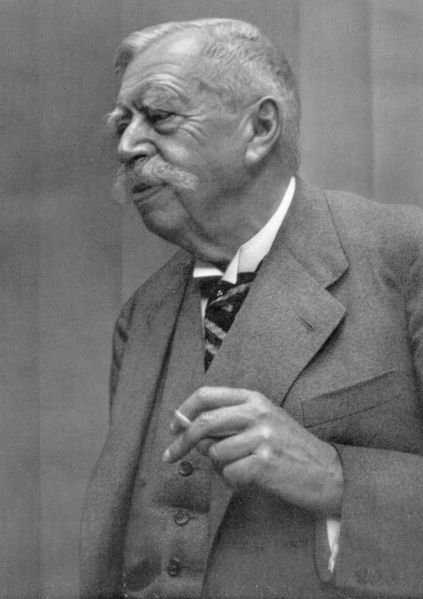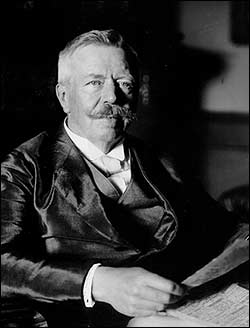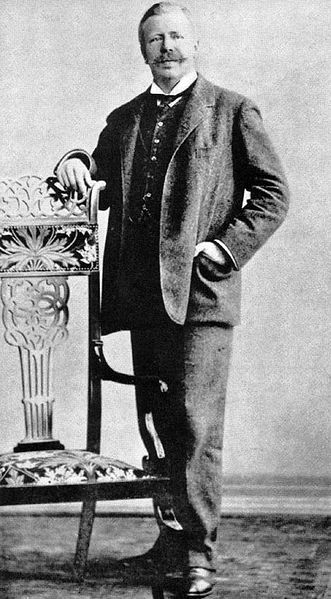<Back to Index>
- Biologist Jakob Johann von Uexküll,
1864
PAGE SPONSOR



Jakob Johann von Uexküll (8 September 1864 - 25 July 1944) was a Baltic German biologist who worked in the fields of muscular physiology, animal behavior studies and the cybernetics of life. However, his most notable contribution is the notion of umwelt, used by semiotician Thomas Sebeok. His works established biosemiotics as a field of research.
Jakob von Uexküll was born in the Keblas estate, Mihkli, Governorate of Estonia. According to Giorgio Agamben, Uexküll was a baron before his family lost most of their fortune in World War I, although Uexküll managed to retain a villa on Capri where the critic, historian and philosopher Walter Benjamin stayed for some time. Needing to support himself, Uexküll took a job as professor at the University of Hamburg where he founded the Institut für Umweltforschung.
Uexküll was interested in how living beings subjectively perceive their environment(s). Uexküll called these subjective spatio - temporal worlds umwelt (German for environment). These umwelten are distinctive from what Uexküll termed the "umgebung" which would be objective reality should such a reality exist.
Uexküll's defines the umwelt as the perceptual world in which an organism exists and acts as a subject. By studying how the senses of various organisms like ticks, sea urchins, amoebae, jellyfish and sea worms work, he was able to build theories of how they experience the world. Because all organisms perceive and react to sensory data as signs, Uexküll argued that they were to be considered as living subjects. This argument was the basis for his biological theory in which the characteristics of biological existence ("life") could not simply be described as a sum of its non - organic parts, but had to be described as subject and a part of a sign system.
The biosemiotic turn in Jakob von Uexküll's analysis occurs in his discussion of the animal's relationship with its environment. The umwelt is for him an environment - world which is (according to Giorgio Agamben), "constituted by a more or less broad series of elements [called] "carriers of significance" or "marks" which are the only things that interest the animal". Agamben goes on to paraphrase one example from Uexküll's discussion of a tick, saying,
"...this eyeless animal finds the way to her watchpoint [at the top of a tall blade of grass] with the help of only its skin’s general sensitivity to light. The approach of her prey becomes apparent to this blind and deaf bandit only through her sense of smell. The odor of butyric acid, which emanates from the sebaceous follicles of all mammals, works on the tick as a signal that causes her to abandon her post (on top of the blade of grass / bush) and fall blindly downward toward her prey. If she is fortunate enough to fall on something warm (which she perceives by means of an organ sensible to a precise temperature) then she has attained her prey, the warm - blooded animal, and thereafter needs only the help of her sense of touch to find the least hairy spot possible and embed herself up to her head in the cutaneous tissue of her prey. She can now slowly suck up a stream of warm blood."
Thus, for the tick, the umwelt is reduced to only three (biosemiotic) carriers of significance: (1) The odor of butyric acid, which emanates from the sebaceous follicles of all mammals, (2) The temperature of 37 degrees Celsius (corresponding to the blood of all mammals), (3) The hairy typology of mammals.
This book is remarkable because it anticipates many of the ideas of computer science and especially robotics some 25 years before the things were invented. For reasons he does not give, he sees organisms in terms of information processing. Every organism has an outer boundary which defines an Innenwelt or inner world and an Umwelt, surround - world or environment. This is basically the black box concept. It has sensors that report the state of the Umwelt and effectors that can change parts of the Umwelt. He was one of the first to identify the effector as the logical opposite of the sensor or sense organ. Sensors and effectors are linked in a feedback loop. Sensor input is processed by a Merkorgan and effectors are controlled by a Werkorgan. He further distinguishes the Umgebung or real external world from the Umwelt proper which is the part of the Umgebung reported by sensors and is the only world known to the organism. This is approximately Kant's phenomenon and noumenon but derived logically from the properties of the sensors. What we call a feedback loop he calls a "function - circle" and "circle" seems to be something like "system". He uses the odd term "melody" to mean something close to "algorithm". He coins around 75 technical terms and a proper understanding of his book would require clearly defining them in modern terms and understanding their relations. He notices qualia, comes close to object - oriented programming uses the image of a helmsman which later showed up as "cybernetics" and makes a good guess about DNA. He has a large number of ideas, any one of which might be very valuable if it were expressed clearly in modern terms. His metaphysics is hyper - Kantian ("All reality is subjective appearance".) Space is a set of direction symbols. He rejects Darwin and says nothing of God. Organisms are based on something called "Plan", the origin of which we cannot know.
Works by scholars such as Kalevi Kull connect Uexküll's studies with some areas of philosophy such as phenomenology and hermeneutics. Jakob von Uexküll is also considered a pioneer of semiotic biology, or biosemiotics. However despite his influence (on the work of philosophers Max Scheler, Ernst Cassirer, Martin Heidegger, Maurice Merleau - Ponty, Georges Canguilhem, Gilles Deleuze and Félix Guattari (in their A Thousand Plateaus), for example) he is still not widely known, and his books are mostly out of print in German and in English. A paperback French translation of Streifzüge durch die Umwelten von Tieren und Menschen [A stroll through the Umwelten of animals and humans] of 1934 is currently in print. This book has been translated in English as A Foray into the Worlds of Animals and Humans, with A Theory of Meaning by Jakob von Uexküll Translated by Joseph D. O'Neil Introduction by Dorion Sagan (2011). The other available book is "Theoretical Biology", a reprint of the 1926 translation of "Theoretische Biologie" (1920). "Foray" is a popular introduction while "Theoretical Biology" is the real thing.
His son was the biologist Thure von Uexküll. His daughter was Sophie Luise Damajanti von Uexküll ('Dana'). His grandson is the writer Jakob von Uexkull.